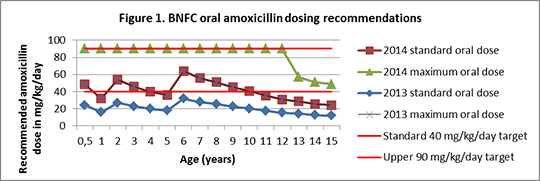Comparison Of Old and New Paediatric Oral Amoxicillin Dosing Recommendations Background and Aims: The British National Formulary for Children (BNFC) provides the standard UK paediatric drug dosing recommendations.1 In April 2014, oral amoxicillin dosing recommendations were revised following concerns that previous doses were too low. This study aimed to analyse the changes in dosing on a weight (mg/kg) basis for children from 6 months to 15 years of age, with reference to standard therapeutic targets, to investigate the effects of the recent changes across different age groups. Methods: The dosing recommendations were obtained from the BNFC editions of 2013 and 2014, respectively. The mean weights for children of different ages were obtained from the 2010 Health Survey for England.2 Standard therapeutic targets were used as reference points: 40 mg/kg/day (minimum target dose in product information) and 90 mg/kg/day (maximum target dose e.g. for acute otitis media).3 Results: The results of the graphical analysis of doses are demonstrated below in Figure 1. Using the 2013 BNFC standard oral dosing regimen resulted in children of mean weights from all age-groups (from 0.5 months to 15 years), i.e. 100% of these year-groups, receiving under the minimum target of 40 mg/kg/day. In contrast, using the new standard dosing regimen from April 2014, children aged 1 year, 5 years or ≥ 11 years-old (i.e. 44% of year-groups) can receive dose regimens equivalent to less than 40 mg/kg/day, on average. The 40 mg/kg/day and 90 mg/kg/day targets are shown for reference.
Conclusions: The revised BNFC oral amoxicillin dosing recommendations from 2014 have increased the proportion of children who should, on average, be receiving a dosage regimen equating to at least 40 mg/kg/day, in keeping with standard therapeutic targets. The limitations of age-based dosing persist, since the resulting mg/kg/day regimens vary widely between children of the same age on different weight centiles. Further analyses are being undertaken to explore the possibility of adopting simplified weight-based oral amoxicillin dosing regimens in the UK, to avoid such variability in paediatric dosing. References: 1. BNF (British National Formulary) for Children. http://www.bnf.org/bnf/ 2. Health & Social Care Information Centre. Health Survey for England — 2010, Trend tables [NS] 3. Saxena S et al. (2014). Br J Gen Pract 64: e217-22.
|


